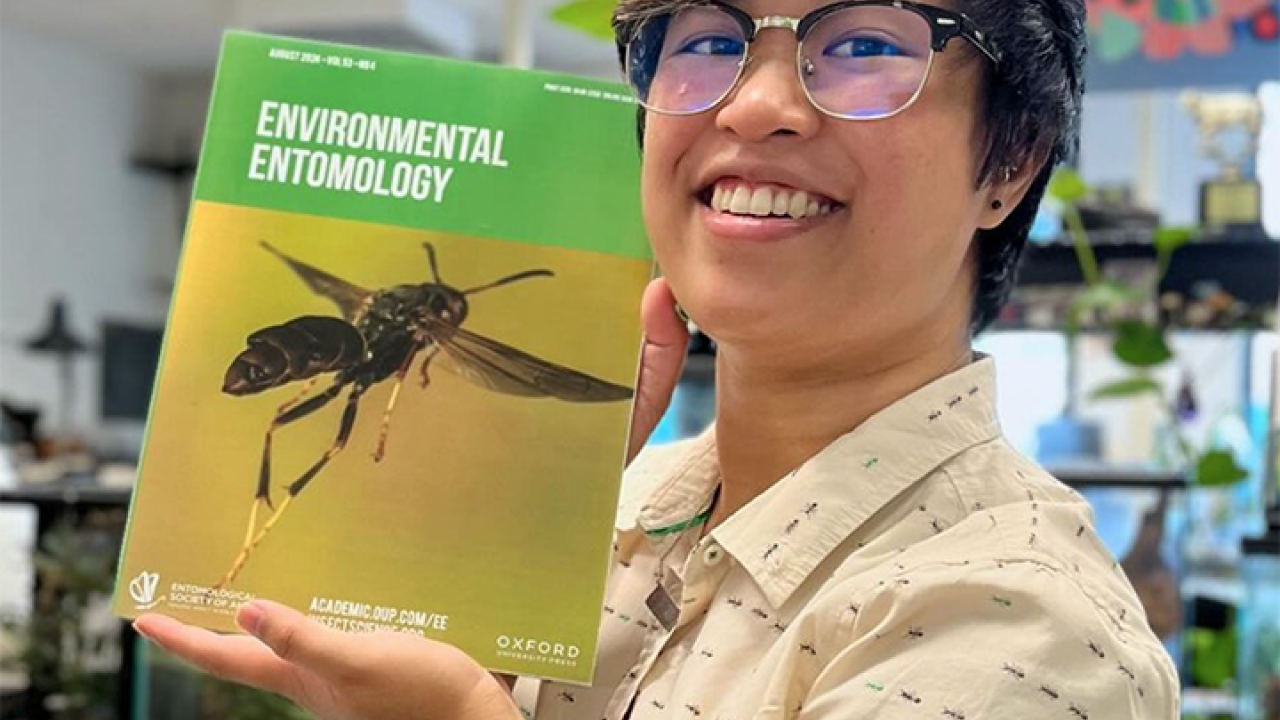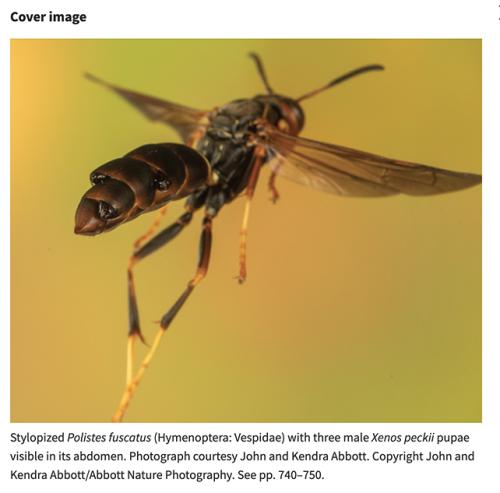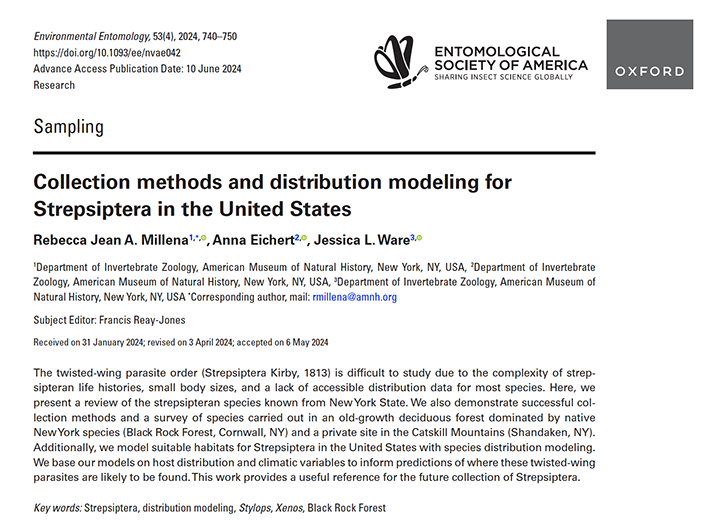
RJ Millena's Research Scores Cover of 'Environmental Entomology'
She's a doctoral candidate at AMNH and a UC Davis alumna

It’s not often that your first doctoral published research makes the cover of an academic journal and focuses on an insect that most people have never heard of--and will probably never see--except in insect museums like the Bohart Museum of Entomology at UC Davis.
Meet UC Davis alumna Rebecca Jean “RJ” Millena, a doctoral candidate of comparative biology in the lab of Professor Jessica Ware, American Museum of Natural History (AMNH). She studies the twisted-wing parasites, order Strepsiptera. As larvae, they enter their hosts, including wasps, bees and cockroaches, through joints or sutures.
Millena’s newly published research, “Collection Methods and Distribution Modeling for Strepsiptera in the United States,” appears in the August issue of the journal Environmental Entomology. On the cover is an image of a parasitized northern paper wasp, Polistes fuscatus, with three male Xenos peckii pupae visible in its abdomen. The image is the work of John and Kendra Abbott of Abbott Nature Photography, Tuscaloosa, Ala.

“The twisted-wing insect parasite order (Strepsiptera) is an excellent example of how beautifully complex evolution and life’s interconnectedness can be,” says Millena, who attends the Richard Gilder Graduate School at AMNH. A 2021 entomology graduate of UC Davis, she is attending AMNH on a four-year, full-ride doctoral fellowship.
“These obligately endoparasitic insects infect several other major orders of Insecta, including true bugs, mantises, cockroaches, flies, wasps, crickets, and even silverfish. Because of this, they can be very difficult to find and study.”
“Our publication aims to help out with that by featuring the first species distribution models for Strepsiptera to predict where we might be able to find them, and detailing collection methods to successfully catch them where they are found,” Millena said.
Co-authors are Anna Eichert, a doctoral candidate of comparative biology in the Ware lab, and Ware, an AMNH evolutionary biologist and curator. Millena credited Kathy LaPoint of Black Rock Forest, Cornwall, N.Y., for images “taken during our collecting trips,” and Abbott Nature Photography for images of a male Xenos peckii in flight and an Isodontia mexicana parasitized by Eupathocera auripedis.
“My work on the evolution and biology of these tiny insects,” Millena said, “is motivated by how much I want everyone to appreciate the unfathomably intricate lives of the organisms we take for granted every day.”

In the paper’s introduction, the authors wrote that Strepsiptera “have a cosmopolitan distribution, but they can be difficult to collect for many reasons. As the larval stages are obligate endoparasites of other insects, strepsipterans are necessarily restricted to the ranges of their hosts and may have patchy distributions among host populations. The neotenic females dwell permanently within the abdomens of their insect hosts, with the exception of some members in the family Mengenillidae. Male strepsipterans can be collected independently of their hosts once they eclose and enter the free-flying adult stage.”
“However, they are likely to still be found within their host ranges since they live for only a few hours and must mate within that time. Females and males range from 0.5 to 5 mm and can be easily overlooked in host abdomens (females) or malaise traps There are no standard procedures for the collection of Strepsiptera, since they parasitize such a wide variety of insect hosts—they are documented to parasitize 7 orders comprising approximately 36 insect families, and these hosts inhabit many different environments.”
Millena has been studying Strepsiptera since her undergraduate years at UC Davis when she was mentored by UC Davis Distinguished Professor (now emeritus) Jay Rosenheim of the Department of Entomology and Nematology.

In 2019, she was one of four UC Davis undergraduates selected for a two-year funded research career with the University of California Leadership Excellence through Advanced Degrees (UC LEADS) program, which prepares promising students for advanced education in science, technology, mathematics and engineering (STEM). The UC LEADS scholars embark upon a two-year program of scientific research and graduate school preparation.
At the time, RJ said: “Being able to work with Jay on this project investigating the host-parasite relationship between Ammophila wasps and Strepsiptera was what made me fall in love with this super weird order of endoparasites."
Over a two-year period, she studied thousands of specimens at the Bohart Museum, which houses about 30,000 specimens of Ammophila from multiple continents. Global wasp authority and UC Davis doctoral alumnus Arnold Menke, author of the book, The Ammophila of North and Central America (Hymenoptera, Sphecidae), identified most of the Ammophila specimens in the Bohart Museum. His book is considered "the bible" of Ammophila research.
RJ went on to enter a poster, “Parental Care and the Risk of Maternally Vectored Pathogens: Ammophila Transmit Strepsipteran Parasites to Their Young,” in the March 2021 Koret UC LEADS Symposium poster competition and won top honors.
In June of 2022, she and Rosenheim authored “A Double-Edged Sword: Parental Care Increases Risk of Offspring Infection by a Maternally Vectored Parasite,” published in Biology Letters, Royal Society Publishing. The paper is online at https://doi.org/10.1098/rsbl.2022.0007
“Strepsipteran parasites hitch a ride on the backs of mother Ammophila wasps to penetrate their nests and attack their vulnerable offspring,” Rosenheim noted. “The study also showed how museum-preserved specimens can be used to address important questions in ecology.”
Millena has pursued her passion to become an entomologist since her first day of kindergarten in Concord. On that day, she wrote “When I grow up, I want to be an entomologist.”
